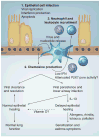Role of infection in the development and exacerbation of asthma
- PMID: 20305826
- PMCID: PMC2840256
- DOI: 10.1586/ers.09.60
Role of infection in the development and exacerbation of asthma
Abstract
Respiratory infections are associated with wheezing illnesses in all ages and may also impact the development and severity of asthma. Respiratory tract infections caused by viruses, Chlamydophila or Mycoplasma have been hypothesized to have significant roles in the pathogenesis of asthma. Progress is being made toward establishing the mechanisms by which these agents can cause acute wheezing and impact the pathophysiology of asthma. Host factors probably contribute to the risk of asthma inception and exacerbation, and these contributions may also vary with respect to early- versus adult-onset disease. This review discusses these various associations as they pertain to the development and exacerbation of asthma.
Keywords: asthma; asthma inception; exacerbation; respiratory infection; virus.
Figures

Similar articles
-
Infections and asthma.Clin Chest Med. 2006 Mar;27(1):87-98, vi. doi: 10.1016/j.ccm.2005.10.004. Clin Chest Med. 2006. PMID: 16543054 Review.
-
The role of pulmonary infection in pediatric asthma.Allergy Asthma Proc. 2007 Mar-Apr;28(2):190-3. doi: 10.2500/aap.2007.28.2964. Allergy Asthma Proc. 2007. PMID: 17479603 Review.
-
The role of respiratory virus infections in childhood asthma inception.Immunol Allergy Clin North Am. 2010 Nov;30(4):513-22, vi. doi: 10.1016/j.iac.2010.08.004. Epub 2010 Sep 22. Immunol Allergy Clin North Am. 2010. PMID: 21029935 Free PMC article. Review.
-
The impact of viral respiratory infection on the severity and recovery from an asthma exacerbation.Pediatr Infect Dis J. 2009 Apr;28(4):290-4. doi: 10.1097/INF.0b013e31819067b1. Pediatr Infect Dis J. 2009. PMID: 19258918
-
Role of viral respiratory infections in asthma and asthma exacerbations.Lancet. 2010 Sep 4;376(9743):826-34. doi: 10.1016/S0140-6736(10)61380-3. Lancet. 2010. PMID: 20816549 Free PMC article. Review.
Cited by
-
Pulmonary Function Testing in Pediatric Pneumonia Patients With Wheezing Younger Than 3 Years of Age.Glob Pediatr Health. 2019 Apr 9;6:2333794X19840357. doi: 10.1177/2333794X19840357. eCollection 2019. Glob Pediatr Health. 2019. PMID: 31008153 Free PMC article.
-
Protection from asthma in a high-risk birth cohort by attenuated P2X(7) function.J Allergy Clin Immunol. 2012 Aug;130(2):496-502. doi: 10.1016/j.jaci.2012.05.040. Epub 2012 Jun 27. J Allergy Clin Immunol. 2012. PMID: 22743305 Free PMC article.
-
Effect of pidotimod combined with azithromycin on children with mycoplasma pneumonia and the expression levels of IL-10 and G-CSF in serum.Exp Ther Med. 2019 Sep;18(3):1800-1806. doi: 10.3892/etm.2019.7725. Epub 2019 Jul 3. Exp Ther Med. 2019. PMID: 31410140 Free PMC article.
-
Asthma-associated bacterial infections: Are they protective or deleterious?J Allergy Clin Immunol Glob. 2022 Sep 20;2(1):14-22. doi: 10.1016/j.jacig.2022.08.003. eCollection 2023 Feb. J Allergy Clin Immunol Glob. 2022. PMID: 37780109 Free PMC article. Review.
-
Phenotypes, Risk Factors, and Mechanisms of Adult-Onset Asthma.Mediators Inflamm. 2015;2015:514868. doi: 10.1155/2015/514868. Epub 2015 Oct 11. Mediators Inflamm. 2015. PMID: 26538828 Free PMC article. Review.
References
-
- Gern JE, Bacharier LB, Lemanske RFJ. Infections and asthma. In: Leung DYM, Sampson HA, Geha RS, Szefler SJ, editors. Pediatric Allergy. Mosby; St Louis, Missouri, USA: 2003. pp. 366–378.
-
- Kusel MM, de Klerk NH, Kebadze T, et al. Early-life respiratory viral infections, atopic sensitization, and risk of subsequent development of persistent asthma. J Allergy Clin Immunol. 2007;119:1105–1110. - PMC - PubMed
-
•• Important study that demonstrated that acute severe lower respiratory tract infection caused by human rhinovirus (HRV) or respiratory syncytial virus (RSV) in the first year of life is strongly associated with the diagnosis of current asthma and persistent wheeze in 5-year-old children, particularly in those who are sensitized during infancy.
-
- Webley WC, Salva PS, Andrzejewski C, et al. The bronchial lavage of pediatric patients with asthma contains infectious Chlamydia. Am J Respir Crit Care Med. 2005;171:1083–1088. - PubMed
-
- Sutherland ER, Brandorff JM, Martin RJ. Atypical bacterial pneumonia and asthma risk. J Asthma. 2004;41:863–868. - PubMed
